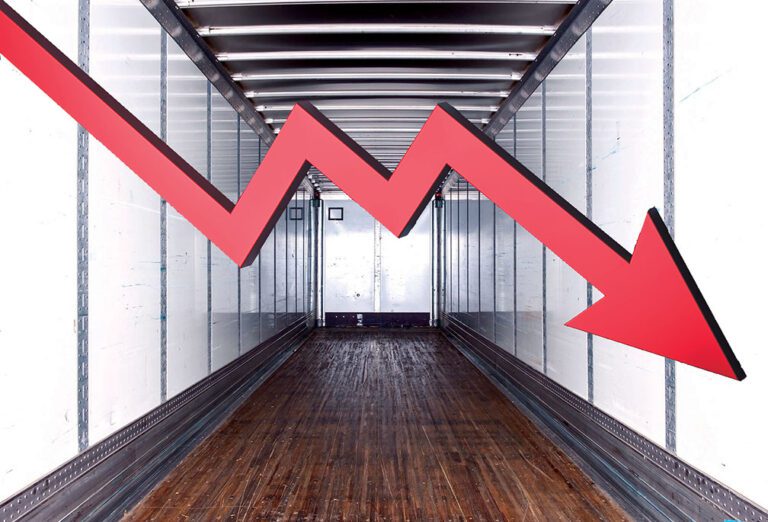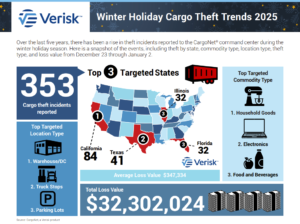The state of the trucking freight market remains murky, as recent reports send mixed messages. During February, the overall outlook spot rates remained suppressed, while contract rates continued a downward trend. Spot rates are notoriously more volatile than contract rates — to the detriment of the smaller carriers who depend on agent freight.
The Cass Freight Index for Shipments, compiled using data from Cass Information Systems, declined by 0.3% in February compared to February 2022. The index increased by 3.8% from January, but when seasonally adjusted it declined by the same 0.3%. If that seems confusing, consider that typical February rates are 4.1% higher than January, so the 3.8% gain fell short of expectations.
The Cass Freight Index for Expenditures is the larger indicator for February. Cass customers typically spend 1.9% less on shipping in February than in January, a number that grows to 3.9% when seasonally adjusted. Comparing current numbers to February 2022 and February 2021, however, provides a better picture of the market. Shipping expenditures this year were 28.4% higher than in February two years ago, but 9.7% lower than February one year ago. That’s an indication that the market, which showed strong growth coming out of the pandemic, has reversed course.
The report, written by Tim Denoyer, vice president and senior analyst for ACT Research, states, “Soft real retail sales trends and ongoing destocking remain the primary headwinds to freight volumes, and sharp import declines suggest this type of environment will persist for several more months.”
The Cass reports reflect primarily trucking data but also include other modes of shipping such as rail, pipeline, ship and air. Specific to trucking, however, is the Cass Truckload Linehaul Index, which fell 0.4% in February after a 0.9% drop in January. Compared to 2022, the January index fell 5.6% from January 2022 and the February index fell 5.6%. The index has fallen in each month since May 2022 as spot rates fell, followed by contract rates.
“At the risk of stating the obvious, the fundamental reason truckload spot rates are still falling is there are too many drivers chasing too little freight,” Denoyer said. “But the freight market is constantly dynamic, and we expect current loose conditions to first rebalance and then tighten over the course of the next year or so.”
A statistic that could help spur spot rates into a climb is a sad one for small carriers. The U.S. Department of Transportation reported nearly 2,000 carrier closings per day during the last quarter of 2022. Many of those were single-truck operations, begun by drivers who purchased trucks to take advantage of record-high spot freight rates, that failed when rates came down.
As those trucks are removed from competition for broker freight, capacity tightens. The “rebalance” suggested by Denoyer indicates that when the number of trucks and loads is in balance, rates should rise again.
We’re not there yet.
A March 13 release from DAT Freight and Analytics reported load-to-truck ratios hitting their lowest point since May 2020 (in the thick of the COVID-19 shutdowns). Simply put, when there are fewer available loads and more trucks competing for them, rates decline.
Spot rates for van and refrigerated freight hit two-and-a-half-year lows, according to the report. The average van spot rate on the DAT load board dropped to $2.24 in February, down 85 cents from February 2022 average rates. Refrigerated rates fared worse at $2.59 per mile, down 95 cents from February a year ago. Flatbed rates fell to $2.70 per mile, 51 cents below the average rate in February 2022.
The DAT release also noted considerable differences between contract and spot rates. Average van contract rates, for example, were 63 cents per mile higher than average spot rates. Refrigerated contract rates were 57 cents higher, and the difference was 73 cents for flatbed rates. Obviously, truckers stand to increase their revenues if they can secure some rates by dealing directly with shippers.
A March 13 Weekly Transportation Update from FTR noted that trucking experienced a sharp decline in employment in February, while the overall economy added 311,000 jobs. Fewer drivers means fewer trucks to haul freight — a factor that could help reverse declining rates. At the same time, the unemployment rate rose to 3.6% in February from a 50-year low of 3.4% in January.
The Motive (formerly Keep Truckin) Monthly Economic Report claimed the trucking industry is rebounding, offering as evidence an increase of 10% in miles traveled compared to February of 2022. The report noted, however, that miles are still 15% lower than 2021 figures.
The culprit is the Consumer Price Index (CPI) issued by the Bureau of Labor Statistics (BLS). According to the BLS, the CPI rose 0.4% in February after climbing 0.5% in January. That doesn’t seem like much but calculated on an annualized basis it’s well above the Federal Reserve’s target of 2% growth for the year. That could trigger another interest rate hike from the Fed.
If there is good news, it’s in the number of new carrier registrations, which rose in February after months of decline. The Motive report states, “The trucking industry has borne the brunt of changing economic tides in 2022, getting punished with high diesel prices, rapidly decreasing volumes, and drastic declines in operating margins. We ended Q4 2022 with historically high out of business rates exceeding what was seen during the 2008-2009 financial crisis and a net contraction in the number of freight companies.”
Adding more trucking companies into the mix, however, is only a good thing if there is freight to haul. The Motive report indicates softness in consumer demand: “Retailers aren’t investing in inventory due to softness in consumer demand, and they’re offering steep discounts to unload existing stock.”
There is a ton of available information, but determining what it all means can be confusing. The peak profit time has ended but there is still money to be made. It’ll take judicious management, including some belt-tightening, for smaller carriers and owner-operators to be successful.
Cliff Abbott is an experienced commercial vehicle driver and owner-operator who still holds a CDL in his home state of Alabama. In nearly 40 years in trucking, he’s been an instructor and trainer and has managed safety and recruiting operations for several carriers. Having never lost his love of the road, Cliff has written a book and hundreds of songs and has been writing for The Trucker for more than a decade.















